"The
Queen City of the South"
Cebu (Sugbo) is the name given to the city, the metropolis, the
island, the province.
Cebu Province is made up of 48
municipalities and 5 cities - Cebu, Danao, Lapu-lapu, Mandaue
and Toledo - with Cebu City as its capital. Cebu Island is a
sliver of an island centrally located in the Visayas region of
the Philippine archipelago, 365 miles south of Manila.
Metropolitan Cebu is a complex of 3 cities and 6 municipalities
with a population of over 1 million. Cebu City is the oldest
Philippine city, and is also called the "Queen City of the
South". As the first Spanish settlement, it was called
Ciudad del Santissimo Nombre de Jesus.
Cebu
City... It is the Philippines' oldest city and carries some of
the country's most priceless
historical relics and monuments. The Magellan Monument marks
where the Spanish discoverer was killed, and the Lapu-Lapu
Monument commemorates the man who slayed him --and who many call
the first Filipino hero.

You can also see
the emblems that Magellan left to commemorate the Filipino's
conversion to Christianity: Magellan's Cross, and the country's
oldest religious relic,
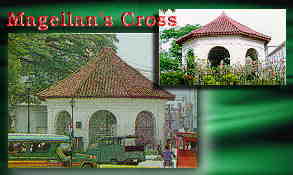
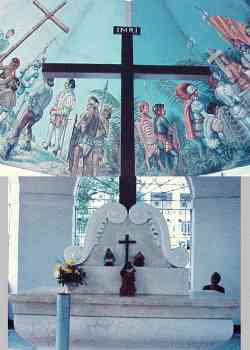
the Image of the
Holy Child Jesus.

The
Image now lies in the Basilica of the Sto. Nino, and is
recognized by the Vatican as the cradle of Christianity in Asia.
The wooden
cross which Magellan brought with him in the year 1521 when he
first set foot in the Philippines at a place called Sugbu, now
Cebu, has been preserved and is now encased in an outer layer of
tindalo wood, mounted on a concrete pedestal, and housed in a
tile-roofed kiosk. At the roof of the kiosk is a painting
depicting the landing of Magellan in Cebu and the planting of
the original cross on the shore.
To Christian Filipinos, this cross symbolizes the victory of
Jesus Christ in the Far East, particularly in the Philippines.
Santo Nino, is with Magellan’s Cross, the most popular
symbol of Cebu. Expressive of the pleasing oppositions in
Cebuano culture, it is at once both foreign and native. In
history, it was made by Flemish artisans, brought to the island
by Ferdinand Magellan in 1521. In local tradition, it is a
miraculous piece of wood, cast out of the Visayan sea,
worshipped from “times immemorial”.
The old church

The new outside prayer grounds

BASILICA
MINOR DEL SANTO NIÑO
– This
church was built by Miguel Lopez de Legaspi and Fr. Andres
Urdaneta on the site where the image of Santo Niño was found in
1565. The first structure of the church was, however, destroyed
by fire on November 1, 1568. It was rebuilt in 1602 under the
administration of Juan Albaran and was rehabilitated in 1740. On
May 1965, the church was conferred the title of Basilica Minor
del Santo Niño Antonuitte, Papal Legate during the Fourth
Centennial celebration of the Christianization of Cebu.Another
famous church is the Chapel of the Last Supper, which has
life-sized, hand-carved statues of Jesus and his disciples
dating back to very early parts during the Spanish occupation.
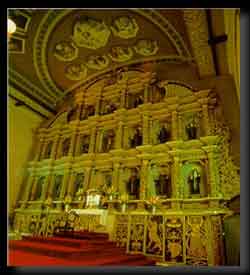
Aside from the relics, Cebu's rich historical roots is
resplendent in its architecture. Fort San Pedro was built by the
Spaniards in the 1700s to repel the Muslim rebels, and the Osmena
Residence houses not only the personal memorabilia of the
country's first president but mementos from General Douglas Mc
Arthur.
FORT
SAN PEDRO NATIONAL COLISEUM,

Legaspi Ext.,
Cebu City-
Artifacts taken from the old Spanish Galleon
known as SAN DIEGO within the deep sea of Fortune Island off the
coast of Nasugbo, Batangas are on display in this centuries-old
Fort. The museum used to house the offices of the Department of
Tourism and the Philippine Tourism Authority.

The artifacts on
display include Ming porcelain pieces of all sizes, coins,
lockets, swords fragments, cannons and helmets. Well-kept flower
beds, cannons, lush vegetation, and neat walkways align its
interiors along with a canteen and a museum.
|
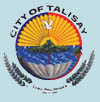
Cebu! View from the hills...

TAOIST
TEMPLE

Located
at Beverly Hills, Cebu City. This temple preserves
the teachings of Lao-Tse, the 600 B.C. Chinese
philosopher. Everyday people climb its 99 steps to
light joss sticks and have their fortune read.

A towering,
multi-tiered, multi-hued attraction accessible by
three separate winding routes. Attractions here
consist of huge, colorful dragon, a replica of the
Great Wall of China, spacious balconies offering
scenic views, souvenir shops, mini library with
instructional materials, and dozens of escalating
steps.
Chinesischer
Tempel, Taoist Temple
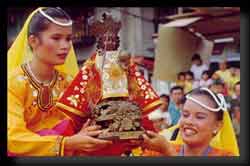
Bahug-Bahugan-Festiva

Sinulog Festival
Every
third Sunday in January starts the Sinulog
Festival coincides with the feast of
the Santo Niño de Cebu, patron saint of the
city of Cebu. The feast day of the Santo Niño
commemorates the baptism of the chieftain of the
province, his queen, and his subjects in 1521.
At this ceremony, an image of the Santo Niño
was presented as a gift to Queen Juana by the explorer
Ferdinand Magellan.
Cebu City is also known for being a commercial center, second
only to Manila. Even before the Spanish arrived it had traded
with the East Indies, Siam and China. Today, tourists still
flock to buy the locally handcrafted instruments, particularly
the guitars, string basses and mandolins.
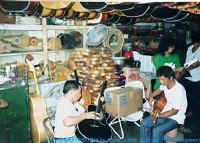
The famous Mactan guitar

And, don't forget the BEACHES!

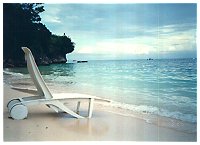

|
